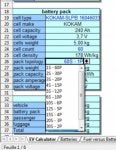I propose a new version of this EV calculator.
The problem I noticed in all EV calculators on the WEB, is that they predict, mileage and other stuff at cruising speed.
As you know, you can eat more energy while you are accelerating to reach the desired speed :
- If you accelerate very slowly, your mileage is low for a longer perdiod of time.
- If you floor the pedal, your mileage is high for a shorter period of time.
I try to address this in this new version, so :
- the parameter "Trottle" tell what your cruising speed will be.
- the parameter "Accel" tell how fast you want to reach the cruising speed.
In the yellow cells you know :
- the cruising speed, depending on "Throttle"
First column
- the energy consumed to go to that speed
- the distance to reach that speed
- the mileage (mean) while getting to that speed
- the time to reach the cruising speed
Second column
- the remaining energy, once you are at the desired speed
- the range
- the mileage
- the time remaining if you ride at the cruising speed
Third column
total energy distance and time, global mileage
You can change any parameters in blue text cells
This calculaor run only with OpenOffice (Apache). LibreOffice is buggy and nobody correct bugs when you ask !!!
The "EV" sheet is protected, to avoid messing up things, but has no password.
The graph may have to axis : "Time" or "Speed"
- When "Time" is applied, the Yaec shows only the "best gears"
- When "Speed" is applied, you have the choice to show the "best gears", or the "full gears", you will notice full gears give different times than best gear as you are suppose to start in the designed gear and hence in may be longer.
You can disable a gear, to simulate a start from 2nd or 3rd gear.
You can change the Cell rate, to see the effect on the Torque and Power curve in "Motor" graph.
You can change cell topology, to get best range or max speed.
You can change grade from -30% to +30%.
Enjoy.
Take into account :
- max motor voltage
- max motor amp
- max battery pack voltage
- max battery pack amp
- C rating setting
- max battery power deliverable
- grade
- Gear
- inertia from equivalent mass of rotating parts
- Speed / Time axis
The problem I noticed in all EV calculators on the WEB, is that they predict, mileage and other stuff at cruising speed.
As you know, you can eat more energy while you are accelerating to reach the desired speed :
- If you accelerate very slowly, your mileage is low for a longer perdiod of time.
- If you floor the pedal, your mileage is high for a shorter period of time.
I try to address this in this new version, so :
- the parameter "Trottle" tell what your cruising speed will be.
- the parameter "Accel" tell how fast you want to reach the cruising speed.
In the yellow cells you know :
- the cruising speed, depending on "Throttle"
First column
- the energy consumed to go to that speed
- the distance to reach that speed
- the mileage (mean) while getting to that speed
- the time to reach the cruising speed
Second column
- the remaining energy, once you are at the desired speed
- the range
- the mileage
- the time remaining if you ride at the cruising speed
Third column
total energy distance and time, global mileage
You can change any parameters in blue text cells
This calculaor run only with OpenOffice (Apache). LibreOffice is buggy and nobody correct bugs when you ask !!!
The "EV" sheet is protected, to avoid messing up things, but has no password.
The graph may have to axis : "Time" or "Speed"
- When "Time" is applied, the Yaec shows only the "best gears"
- When "Speed" is applied, you have the choice to show the "best gears", or the "full gears", you will notice full gears give different times than best gear as you are suppose to start in the designed gear and hence in may be longer.
You can disable a gear, to simulate a start from 2nd or 3rd gear.
You can change the Cell rate, to see the effect on the Torque and Power curve in "Motor" graph.
You can change cell topology, to get best range or max speed.
You can change grade from -30% to +30%.
Enjoy.
Take into account :
- max motor voltage
- max motor amp
- max battery pack voltage
- max battery pack amp
- C rating setting
- max battery power deliverable
- grade
- Gear
- inertia from equivalent mass of rotating parts
- Speed / Time axis

















